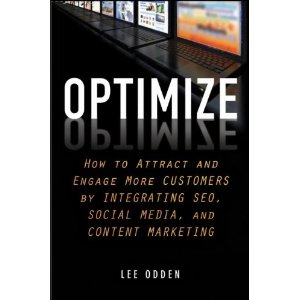
An increasing number of companies feel they have a solid content marketing strategy and tactical mix in place. Now it’s time to think about how to integrate an “Optimize and Socialize” approach into the overall online marketing program.
Two key considerations for implementing a scalable “Optimize and Socialize” content marketing approach involve where SEO and social media optimization fit within the content planning and publishing process and the skills of Social Media and SEO content creators. Here is a small business example that uses an Online Marketing Audit to start finding the answer to those questions about process and skills.
Small Business Marketing Problem: No Time For Content
Tom started his own video game accessories business 5 years ago and has enjoyed steady, yet modest growth despite a fluctuating economic environment. Tom is a very hands-on boss with his small business and is doing much of the marketing himself through his website, which attracts about 75% of the orders through natural search, links and some social traffic. He also manages an email newsletter and does some PPC advertising.
Tom has tried starting and maintaining a presence on Facebook, Twitter and several industry forums, but his available time for social networking has reduced considerably. An ex-corporate marketer, Tom realizes the importance of content for his website as well as a social presence. However, he simply doesn’t have the time or resources. Or so he thinks.
Recommendations for Tom’s Video Game Accessories Business:
If Tom is going to continue performing the marketing tasks for his small business himself, he’ll want to be more intentional about how he uses his website to reach customers vs. simply maintaining the site with content about products and services information. Paying an outside resource to conduct an Online Marketing Audit of his website, blog and social media marketing should be a consideration.
An audit will provide a roadmap that identifies goals, key customer segments and what motivates them to engage and buy his video game accessories. Armed with these insights, Tom can prioritize his time to work more efficiently on marketing tasks with the highest impact.
For the sake of this example, let’s say Tom’s approach to content will focus on answering key questions his ideal customers ask during the consideration and decision portions of the buying cycle. Knowing that it would be very difficult to achieve industry authority for generic search terms and social topics, Tom’s best bet with limited marketing resources is to capture prospective customers with content that answers important buying questions before purchase.
Tom’s Online Marketing Audit will identify relevant search keywords and social topics that are in demand as well as the content types and formats that will best attract, engage and inspire his ideal customers. With a more intentional and customer-centric online marketing plan in place, he’ll understand what types of content needs to be created and the channels where that content should be promoted in order to attract the right customers.
Online Marketing Skills Training: Tom will need to reconcile his current skills and internal resources with what he’ll need to know for content planning, optimization, social promotion and measurement. What he can’t do himself, he may need to source internally, re-prioritize or look externally.
For example, if the audit indicates customers will be most motivated by video content, then he’ll want to brush up on his video editing skills or find a reasonable vendor he can outsource to. If Tom has other employees that have product expertise, he’ll want to offer some kind of training in order for them to help with SEO copywriting, social network development and engaging with customers on industry forums and social networks.
One of the most important online marketing training investments Tom could make is with social media monitoring and web analytics. Google offers free online classes with Google Analytics that can be a great way to build a foundation for understanding how people find and engage with content on his website. A simple social media monitoring tool like Trackur could give Tom a quick heads up whenever the gaming community mentions his products or talks about his company.
It’s not reasonable for Tom to expect himself to know everything the Online Marketing Audit calls for, so he should manage what he’ll need to learn himself, what his employees will help with and what outside resources or tools will be needed.
Optimizing Marketing Processes: An editorial plan that is thoughtful about customer needs and pain points will be instrumental for Tom’s content creation effectiveness both short and long term. He can identify which content will be created and by whom as well as determining the particular media formats to use.
Content re-purposing can be planned out with his customer email newsletter and any other social or editorial promotion he’s involved with. Along with planned content creation, optimization and social promotion processes, Tom can schedule time between himself and several members of his staff for community engagement and social network development using HootSuite or a similar low cost social media management tool.
Reporting from web analytics and social media monitoring will help Tom refine the messages he publishes on social channels and on the website for better performance. Scheduling these activities on a regular basis will help make them a habit. Well defined processes and policies will ensure quality across employees who are helping.
Following a schedule and set of processes will help Tom implement search and social media friendly content that best attracts, engages and inspires his ideal prospects when they are looking to buy. Growing his skills at content creation as well as monitoring and measurement will help Tom better evaluate the performance of his content marketing efforts and make adjustments accordingly.
The longer Tom follows his plan and processes for content creation, optimization and social network growth, the more entry points he’ll create for customers to find out about his business through search engines, links and social media referrals. Following a plan, improving skills and enlisting help will provide Tom’s business with improved search and social media visibility without taking too much time away from other responsibilities.
3 Key Phases of a Social, SEO and Content Marketing Audit
- Discovery: Research and document the current situation, goals, challenges, competitive environment and resources.
- Assess: Review the current approach, process, SEO and Social Media readiness. Evaluate current Content Marketing efforts and identify areas of opportunity.
- Recommend: Provide best practices Social, SEO and Content Marketing processes and tools.
 Excerpted with permission from Wiley – Optimize: How to Attract, Engage and Convert More Customers by Integrating SEO, Social Media and Content Marketing.
Excerpted with permission from Wiley – Optimize: How to Attract, Engage and Convert More Customers by Integrating SEO, Social Media and Content Marketing.
Postscript:
One of the pages that didn’t make it into my book Optimize (I still don’t know why) was the following collection of praise quotes from a group of marketing rock stars that I highly respect. I sincerely appreciate that they took the time to write these comments about Optimize and am proud to share their thoughts here:
“There’s a lot of ready, fire, aim happening in content marketing today. In Optimize, Lee Odden gives us important blueprints for sound, smart, strategic, and measured content programs. Required reading for any online marketer or communicator, Optimize includes tens of thousands of dollars worth of spot-on advice.”
Jay Baer – Best Selling Author, Keynote Speaker and President of Convince and Convert
“Lee Odden is one of the true thought leaders in an industry where you are not always sure who to trust. Well, you can trust this book to help take your online and content marketing to the next level. Lee details both the strategy and the tactics to position your company as the true industry expert online. Everyone has content, but not everyone knows how to optimize that content for success. Lee shows you how in a way that makes sense for large or small brands alike.”
Joe Pulizzi – Author, Founder of Content Marketing Institute and Content Marketing World
“If you want to be easily discovered by your ideal customers and prospects, then you need to study the principles clearly outlined in Lee Odden’s book Optimize. You’ll discover why social and search must coexist and precisely what your business needs to do about it.”
Michael Stelzner – Author, Founder of Social Media Examiner and Social Media Marketing World
“Optimize highlights a test, learn and scale philosophy – vital to winning customer’s attention given the ever changing landscape of the web. Odden provides rich insight towards digital continual improvement; integrating SEO, social media and content strategy.”
Amy Lamparske – Director, Digital Marketing at Walmart eCommerce
“Optimize offers business owners a cutting edge methodology to more effectively create and optimize content by using high value signals such as buy cycle, persona, interest and intent thereby increasing engagement and retention that is guaranteed to improve digital marketing performance and increase revenue.”
Bill Hunt – CEO, Back Azimuth Consulting & Co-Author of Search Engine Marketing Inc.
“Lee’s no fly-by-night seo and social media “guru”, he’s the real deal. He’s always sought effective results and ROI for his clients, and always communicated his advice excellently through his blog and at conferences around the world. Now you hold that wisdom in your hands. Cherish it, adhere to it, and have fun implementing it!”
Mel Carson – Author, Founder of Delightful Communications (Previously Digital Marketing Evangelist, Microsoft Advertising)
Photo: Shutterstock


